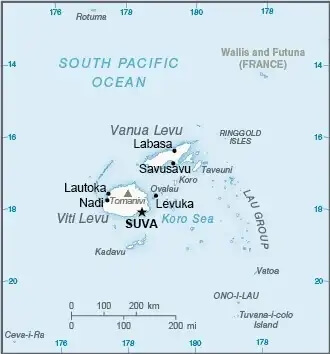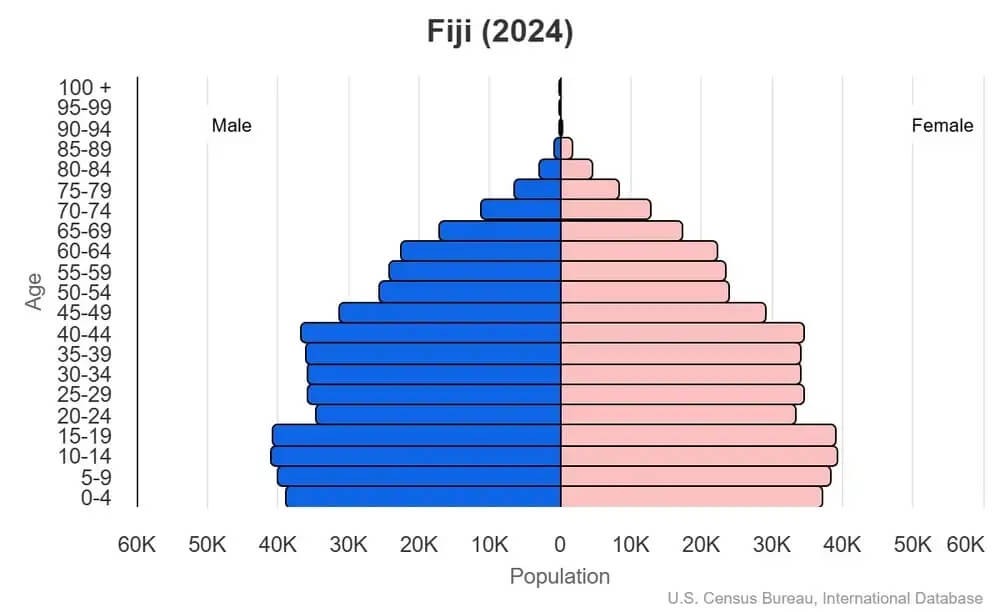World Book
Fiji
Introduction
Background
Fiji became independent in 1970 after nearly a century as a British colony. Coups and a 1990 constitution that cemented native iTaukei control of Fiji led to heavy Indian emigration. The population loss resulted in economic difficulties but ensured that ethnic iTaukei became the majority. A new constitution enacted in 1997 was more equitable.
Geography
Area
total : 18,274 sq km
land: 18,274 sq km
water: 0 sq km
Climate
tropical marine; only slight seasonal temperature variation
Natural resources
timber, fish, gold, copper, offshore oil potential, hydropower
People and Society
Population
total: 951,611 (2024 est.)
Ethnic groups
iTaukei 56.8% (predominantly Melanesian with a Polynesian admixture), Indo-Fijian 37.5%, Rotuman 1.2%, other 4.5% (European, part European, other Pacific Islanders, Chinese) (2007 est.)
Languages
English (official), iTaukei (official), Fiji Hindi (official)
Religions
Protestant 45% (Methodist 34.6%, Assembly of God 5.7%, Seventh Day Adventist 3.9%, and Anglican 0.8%), Hindu 27.9%, other Christian 10.4%, Roman Catholic 9.1%, Muslim 6.3%, Sikh 0.3%, other 0.3%, none 0.8% (2007 est.)
Population growth rate
0.4% (2024 est.)
Government
Government type
parliamentary republic
Capital
name: Suva (on Viti Levu)
Executive branch
chief of state: President Ratu Naiqama LALABALAVU (since 12 November 2024)
head of government: Prime Minister Sitiveni Ligamamada RABUKA (since 24 December 2022)
Diplomatic representation in the US
chief of mission: Ambassador Ilisoni VUIDREKETI (since 17 June 2024)
Diplomatic representation from the US
chief of mission: Ambassador Marie DAMOUR (since 24 November 2022); note - also accredited to Kiribati, Nauru, Tonga, and Tuvalu
Economy
Economic overview
upper-middle income, tourism-based Pacific island economy; susceptible to ocean rises; key energy and infrastructure investments; post-pandemic tourism resurgence; improved debt standing; limited workforce
Real GDP (purchasing power parity)
$13.1 billion (2024 est.)
$12.617 billion (2023 est.)
$11.734 billion (2022 est.)
Real GDP per capita
$14,100 (2024 est.)
$13,700 (2023 est.)
$12,800 (2022 est.)
Exports
$2.376 billion (2022 est.)
$1.171 billion (2021 est.)
$1.23 billion (2020 est.)
Exports - partners
USA 32%, Australia 12%, Tonga 6%, NZ 6%, Samoa 4% (2023)
Exports - commodities
water, fish, raw sugar, refined petroleum, garments (2023)
Imports
$3.434 billion (2022 est.)
$2.344 billion (2021 est.)
$1.977 billion (2020 est.)
Imports - partners
Singapore 25%, China 16%, Australia 15%, NZ 14%, USA 5% (2023)
Imports - commodities
refined petroleum, medical instruments, cars, broadcasting equipment, plastics (2023)
Human Development Index
The country's Human Development Index (HDI) is 0.731, ranking it 111th out of 193 countries tested. (more information)



